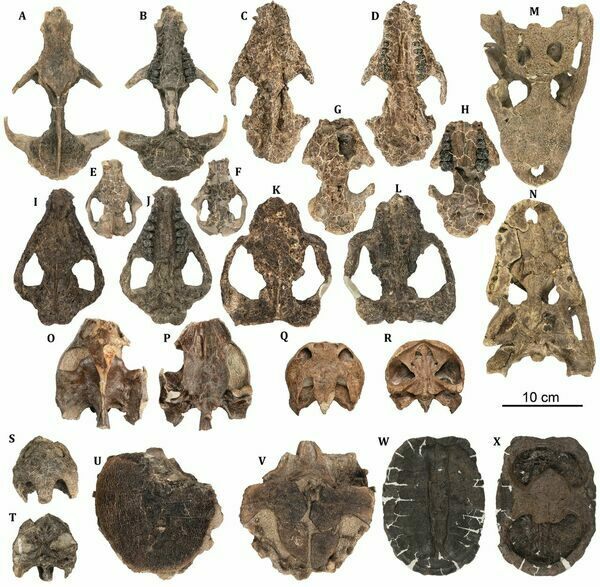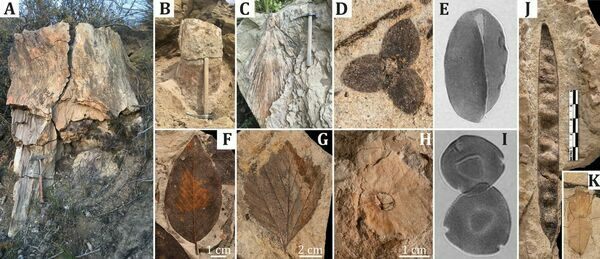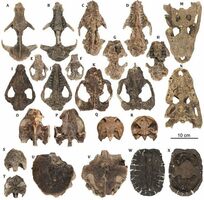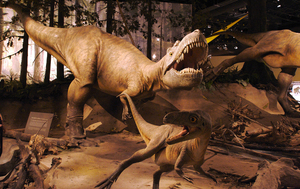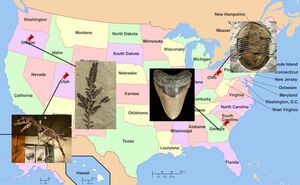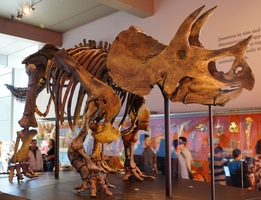New Fossil Discovery Shows The Rapid Rise Of Mammals After KT Extinction
The Denver Museum Of Nature and Science has announced a significant, new fossil discovery documenting the rapid rise of mammals after the KT extinction event which killed over 75% of life on earth. Research on fossils recently uncovered at Corral Bluff in the Denver Basin show a much more rapid recovery of both flora and fauna than previously believed after the demise of the dinosaurs. Remarkably, within just several hundred thousand years, both plant and mammal diversity was greater than before for the extinction event with mammals increasing in size one hundred fold.
Corral Bluffs was the site of continuous deposition for one million years from the late Cretaceous to the early Paleocene. Unlike many areas that have deposits from either before or after the asteroid impact which sparked the extinction, the rocks are Coral Bluffs record an unbroken timeline. This is where Ian Miller and Tyler Lyson of the Denver Museum of Nature and Science discovered hundreds of fossils in concretions, including those of mammals, turtles, crocodilians and plants.
The fossils they recovered and studied included one one hundred eight turtles, seventy three mammals, nine crocodilians, four dinosaurs, two fish and one Champsosaurus as well as six thousand leaves and thirty seven thousand pollen grains representing two hundred thirty three species, were found in the study area. Two hundred and one of the two hundred ninety nine vertebrate specimens were found in concretions.
With so many different plants and vertebrate fossils to work with, Miller and Lyson were able to construct a remarkably detailed view of how life recovered after the KT extinction event. The asteroid impact that occurred roughly 66 million years ago killed seventy five percent of all life on earth, including the dinosaurs and all mammals larger than a rat. The fossil record of life after that event had previously been sparse and largely disjointed. This is what makes the Corral Bluffs discovery so special. It contains deposits and fossils from both sides of the KT boundary as well as the boundary itself. In addition it contains a very diverse set of both flora and fauna.
Using fossils and formulas, Miller and Lyson drew a highly detailed picture of how life after the asteroid impact occurred. The fossils of mammals and plants provide an almost step by step picture of “what happened next”.
In the first one thousand years after the asteroid impact mammals were largely omnivorous or insectivorous and very small, about the size of a modern rat. Nice species of mammals were found at Corral Bluffs with the largest estimated to be around 600 grams (21 ounces). The botanical habitat was largely comprised of ferns and flowering plants with diversity only about half of what it had been during the Cretaceous.
Only one hundred thousand years later, floral composition had changed to palm forests. The size of mammals had increased to that of a modern raccoon, about the maximum size of mammals before the extinction. It is believed that this change is at least partially due to a rapid 5 degree celsius (9 degree fahrenheit) increase in temperature as the climate stabilized.
Three hundred thousand years after the impact, the temperature again rose by a similar amount, possibly due to volcanic activity releasing greenhouse gasses into the atmosphere. This led floral composition to a change from palm forests to walnut like forests. Flowering plant diversity was once again at a level similar to what they had been. Mammalian diversity had increased threefold and the largest mammals were now about the size of a beaver, fifty five pounds or twenty five kilograms. This was significantly larger than the largest mammals before the KT extinction.
About seven hundred thousand years later a third warming event occurred. Flowering plant diversity and composition had increased and now included legumes. Peas and beans are incredibly nutritious and this may be a large part of the reason mammal body mass had increased one hundred fold over where it had been immediately following the impact. The largest mammals at the time weighed over 100 pounds (55 kilograms). In addition the forests that had flourished before the asteroid impact appear to have fully recovered, albeit with new species.
Miller and Lyson’s research found that plant diversity and richness are tied to the three warming intervals following the KT extinction. This in turn changed food availability and nutrition resulting in an increase in mammalian composition and diversity as well. Mammals had gone from nine, omnivorous or insectivorous taxa to about thirty with diverse diets that allowed for a huge increase in body mass.
Streaming now from Nova - Rise of the Mammals
Learn More From The Denver Museum Of Nature And Science
RESEARCH ARTICLE - Exceptional continental record of biotic recovery after the Cretaceous–Paleogene mass extinction
Corral Bluffs was the site of continuous deposition for one million years from the late Cretaceous to the early Paleocene. Unlike many areas that have deposits from either before or after the asteroid impact which sparked the extinction, the rocks are Coral Bluffs record an unbroken timeline. This is where Ian Miller and Tyler Lyson of the Denver Museum of Nature and Science discovered hundreds of fossils in concretions, including those of mammals, turtles, crocodilians and plants.
The fossils they recovered and studied included one one hundred eight turtles, seventy three mammals, nine crocodilians, four dinosaurs, two fish and one Champsosaurus as well as six thousand leaves and thirty seven thousand pollen grains representing two hundred thirty three species, were found in the study area. Two hundred and one of the two hundred ninety nine vertebrate specimens were found in concretions.
With so many different plants and vertebrate fossils to work with, Miller and Lyson were able to construct a remarkably detailed view of how life recovered after the KT extinction event. The asteroid impact that occurred roughly 66 million years ago killed seventy five percent of all life on earth, including the dinosaurs and all mammals larger than a rat. The fossil record of life after that event had previously been sparse and largely disjointed. This is what makes the Corral Bluffs discovery so special. It contains deposits and fossils from both sides of the KT boundary as well as the boundary itself. In addition it contains a very diverse set of both flora and fauna.
Using fossils and formulas, Miller and Lyson drew a highly detailed picture of how life after the asteroid impact occurred. The fossils of mammals and plants provide an almost step by step picture of “what happened next”.
The story of the discovery is the subject of a new documentary, NOVA Rise of the Mammals, streaming now and airing Wednesday, October 30 at 9pm ET/8C on PBS.
In the first one thousand years after the asteroid impact mammals were largely omnivorous or insectivorous and very small, about the size of a modern rat. Nice species of mammals were found at Corral Bluffs with the largest estimated to be around 600 grams (21 ounces). The botanical habitat was largely comprised of ferns and flowering plants with diversity only about half of what it had been during the Cretaceous.
Only one hundred thousand years later, floral composition had changed to palm forests. The size of mammals had increased to that of a modern raccoon, about the maximum size of mammals before the extinction. It is believed that this change is at least partially due to a rapid 5 degree celsius (9 degree fahrenheit) increase in temperature as the climate stabilized.
Three hundred thousand years after the impact, the temperature again rose by a similar amount, possibly due to volcanic activity releasing greenhouse gasses into the atmosphere. This led floral composition to a change from palm forests to walnut like forests. Flowering plant diversity was once again at a level similar to what they had been. Mammalian diversity had increased threefold and the largest mammals were now about the size of a beaver, fifty five pounds or twenty five kilograms. This was significantly larger than the largest mammals before the KT extinction.
About seven hundred thousand years later a third warming event occurred. Flowering plant diversity and composition had increased and now included legumes. Peas and beans are incredibly nutritious and this may be a large part of the reason mammal body mass had increased one hundred fold over where it had been immediately following the impact. The largest mammals at the time weighed over 100 pounds (55 kilograms). In addition the forests that had flourished before the asteroid impact appear to have fully recovered, albeit with new species.
Miller and Lyson’s research found that plant diversity and richness are tied to the three warming intervals following the KT extinction. This in turn changed food availability and nutrition resulting in an increase in mammalian composition and diversity as well. Mammals had gone from nine, omnivorous or insectivorous taxa to about thirty with diverse diets that allowed for a huge increase in body mass.
More Information:
Streaming now from Nova - Rise of the Mammals
Learn More From The Denver Museum Of Nature And Science
RESEARCH ARTICLE - Exceptional continental record of biotic recovery after the Cretaceous–Paleogene mass extinction
 Reviews
Reviews

